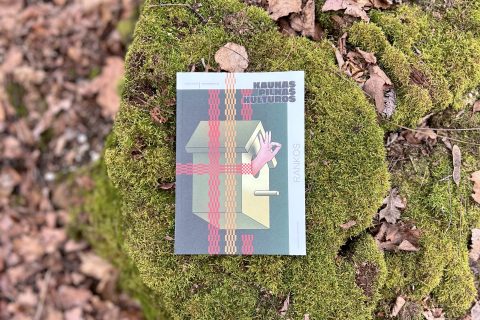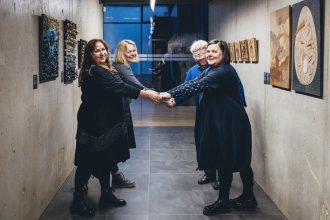Pensive Christ has this very Lithuanian quality that describes both our character and our past. The Lithuanian history of the last couple of centuries fits perfectly into the image of a lonely, pensive, person, who had to sit down due to exhaustion caused by all the chaos. Although other nations have similar ones, in Lithuanian culture it was established as one of the essential (religious) symbols, recognized by both young and old. I talked to Adolfas Teresius, who has crafted perhaps the largest number of Pensive Christs (but not only) in the country. He is a folk artist, a sculptor, a teacher, or perhaps more precisely, a true god-maker.
There is probably nothing more inspiring than creators, who are extremely passionate about their work. Before I went to meet my interviewee, I looked at his publicly available photos and realized that I would be talking to a person whose smile never leaves his face.
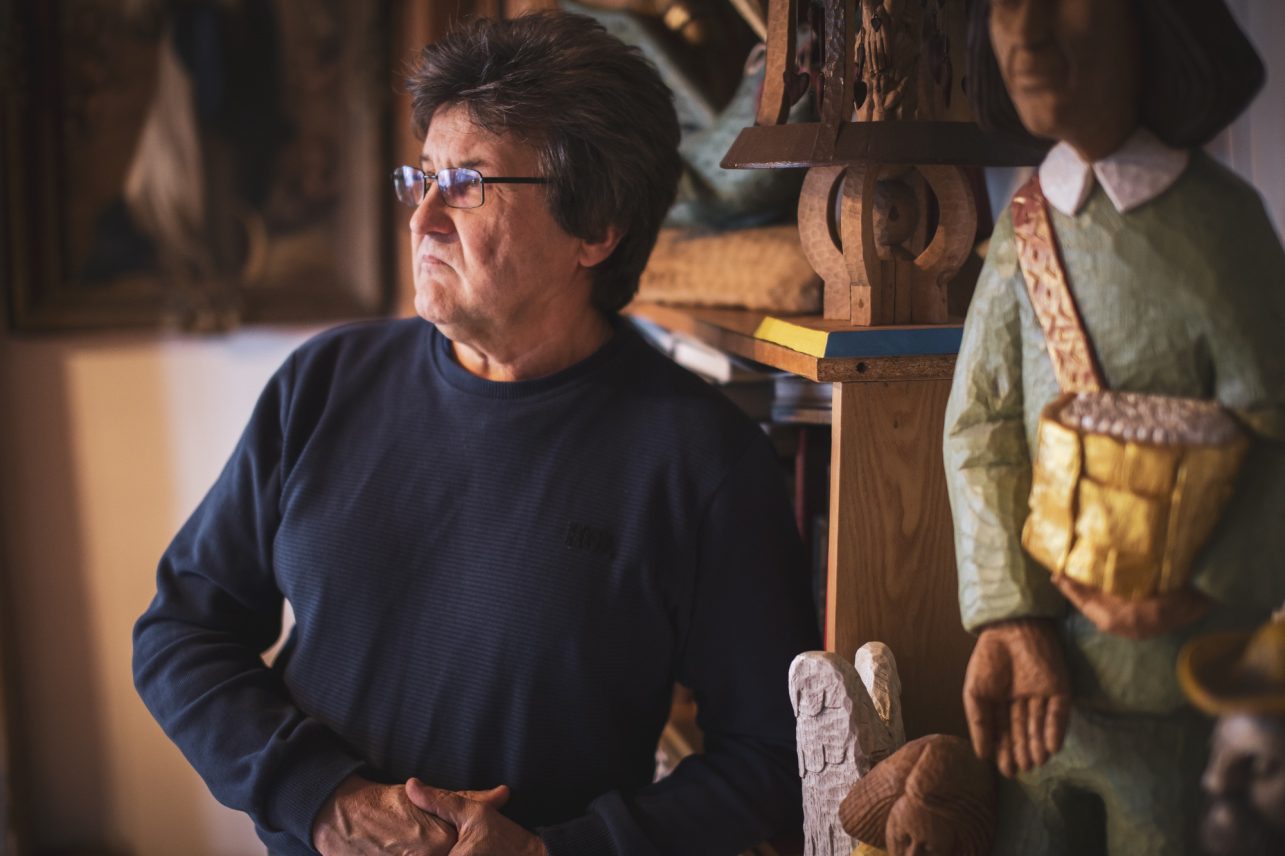
When I reached his yard full of objects made of wood, that was exactly how he greeted me – with a smile worthy of a commercial, full of youthful energy, a very polite man with strong hands. As soon as I walk through the door, I realize that when I leave, I will no longer dream of writing, but of learning his craft.
His story is not that cheerful
Although Adolfas has been living near Kaunas, in Garliava, for so many years that he could easily call himself a local, his roots are in Samogitia, Kelmė district. The artist says that he did form as a person here because he arrived married, with a job, but wasn’t yet serious when it came to his creative work. “I wonder when I will sober down. Maybe when that day comes, I won’t be working anymore. While I am still interested and curious, I create and play. And it’s been like this for 40 years,” the folk artist begins the conversation about his youth.
And his youth was not easy. I assumed that the artist came to Kaunas to study or after his appointment, maybe to some art combine, but I was wrong. Adolfas is a self-taught artist whose choice to create is strongly linked to the oppression of the evil empire at the time.

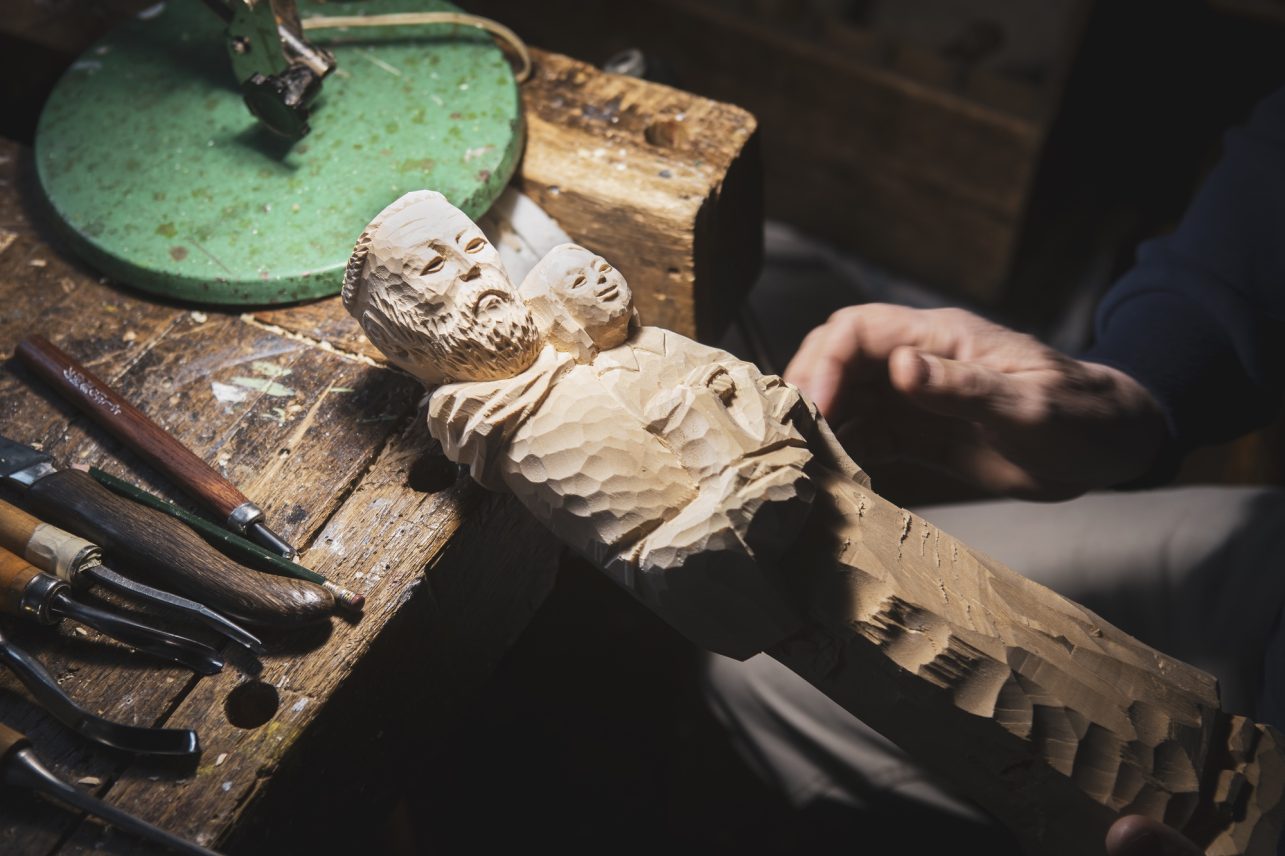
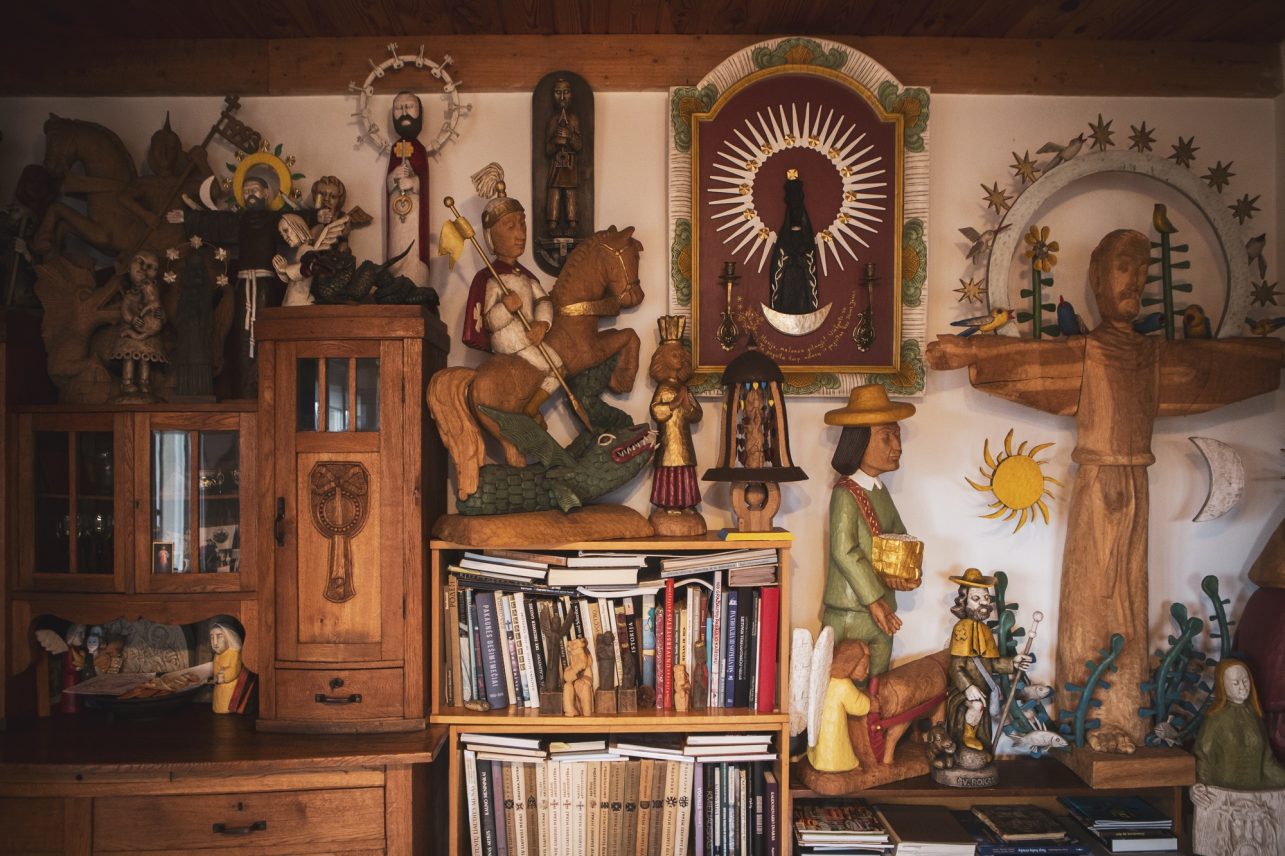
He is not only the winner of various cultural awards and prizes. In 2007, he was also recognized as a participant in the freedom struggle. His biography includes many works dedicated to other resistance fighters and partisans.
“First there was no art involved, I had to repair and restore. Things they did not allow us to repair or maintain, for example, wayside shrines. We were outsiders. We knew that we would have to pay one way or another for each activity. And so, we did,” A. Teresius remembers his first woodworks.
Man vs system
“I encountered it first, right after the army when I was about 20 years old. There was this cross in Šlavantai, Lazdijai district and we took care of it knowing that it would be taken down. We went there a lot because we were passionate about it. One day, when we came to look at it, we found only half of it,” he recalls grimly.
One thing led to another, and finally, my interviewee and his friends were beaten by the KGB agents, handcuffed, and had the cold barrel of a gun pressed to his warm forehead. The presence of a priest made the situation better.
“It was tough, but we certainly didn’t stop there. Adrenaline? No. This is what the country needed. We would probably have been able to count the people who dared to behave like that on the fingers of all our hands. Later searches and arrests followed. That is why I could not attend university, I did not learn a trade,” Adolfas continued.
The ideas stemmed from the church
It’s no secret that the god-maker also contributed to the distribution of the illegal, Catholic, Lithuanian press. The artist has mentioned his influences more than once in various interviews but emphasizes that two people were the most important in his life. The picture of one of them can be seen as soon as we enter his workshop. “Father Stanislovas was one of the most important people in my life. I was introduced to him by another person who was equally important to me, Jurga Šeduikytė’s father, organist Alvydas Šeduikis.”
In the late Soviet era, the ideas of Lithuanianness were spread quite strongly through the church. According to Adolfas, secular national movements were quickly tracked down and dismantled by the secret services. Although the Soviets officially looked down on religions, they were somewhat afraid of them and did not bother religious institutions that much.
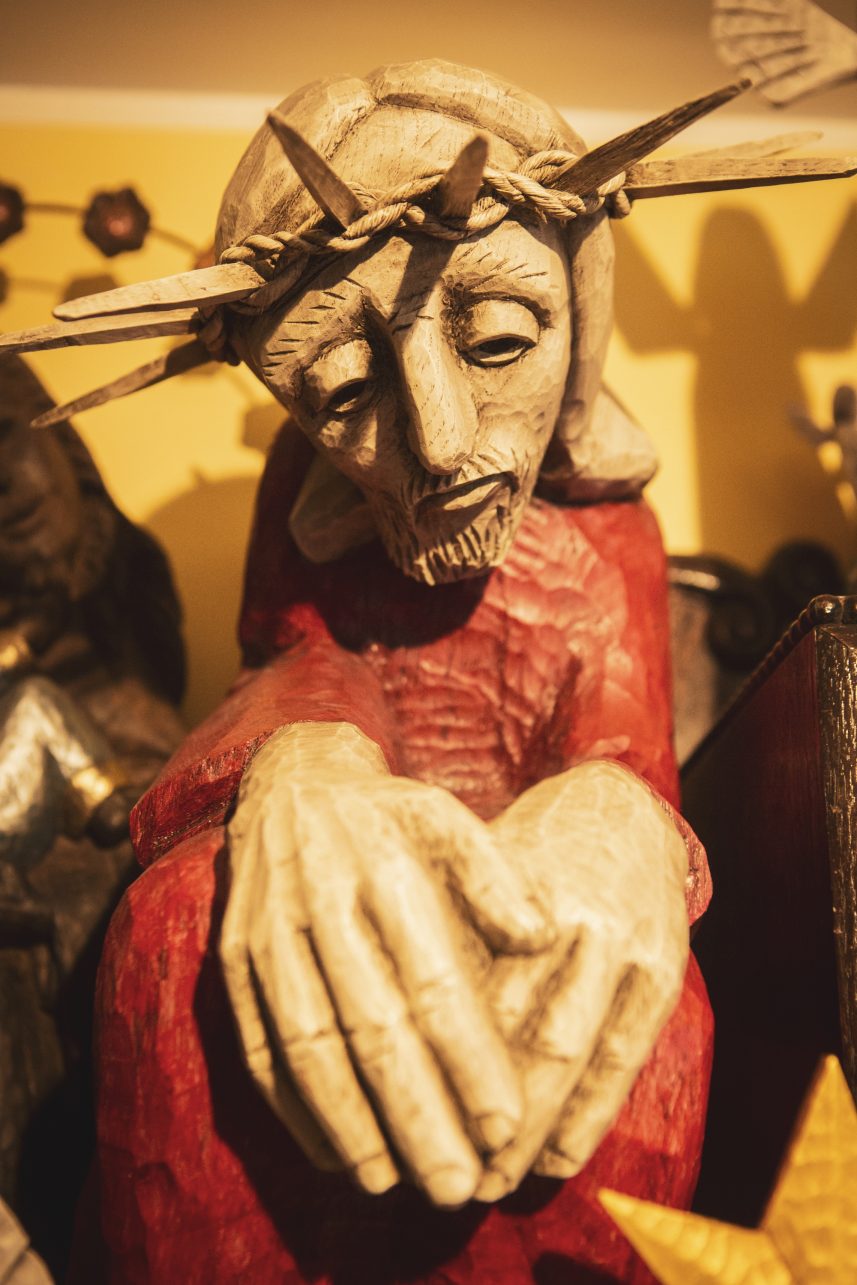
The structure of the church was helpful. Its networks were used for communication across Lithuania. Some priests were not afraid: they both resisted and accepted young people who wanted to resist. That helped a bit; served as a cover.
“Father (Stanislovas) used to say: the wayside shrines were pulled out, make me these saints of these dimensions, we will recreate them. I make the statuettes and pass them to him. Someone then puts them up. There was a conspiracy. I only learned the identity of some of my accomplices several dozen years later. It was simpler that way.”
Craftsmanship turned into art
“I began with wayside shrines. That’s probably why I understand that religious theme very well and continue working with it as an artist. People often ask me why I don’t make some gnomes or benches. The truth is, I don’t want to, and it would be insincere,” the artist says.
Adolfas Teresius’ works were acquired by The National Museum of Lithuania. It bought a dozen of them in four instances. The author has not counted all the carvings but says that there are definitely thousands. He has organized more than 50 solo exhibitions and was part of over a hundred group ones.
“I chose a long-lasting material. Bakers are also artists, but their material is doomed to be consumed quickly. The wood will also rot, but it will be able to make you happy longer. Wood is so… real. if I carved them out of stone, they’d be rolling around throughout history,” the god-maker jokes.
The artist tells me that there is no shortage of orders: there is probably a year-long queue of people who want his work. He no longer has time to attend the creative camps, and often has to say no to invitations. He does not show initiative anymore and does not advertise his work or sell it in galleries. He stays here, at home.
Widely dispersed
Lithuanians of today want to have a Pensive Christ at home too. My interviewee’s ‘idols’ as he calls them, can be found everywhere.
“I had an exhibition in the Hermitage Museum. I made an altar for the Catholic church in Murmansk, and someone from St. Petersburg noticed and invited me. For me, as a humble artist, exhibiting in one of the most famous museums in the world was quite an achievement. Now, of course, the situation is different.”
Adolfas does not single out his most memorable work. He is modest and doesn’t admit to it, but as I understand, even popes, both Francis and Benedict XVI, have his works. His wooden objects traveled to UNESCO headquarters with former president Valdas Adamkus, after cross-crafting was put on the Representative List of the Intangible Cultural Heritage of Humanity.
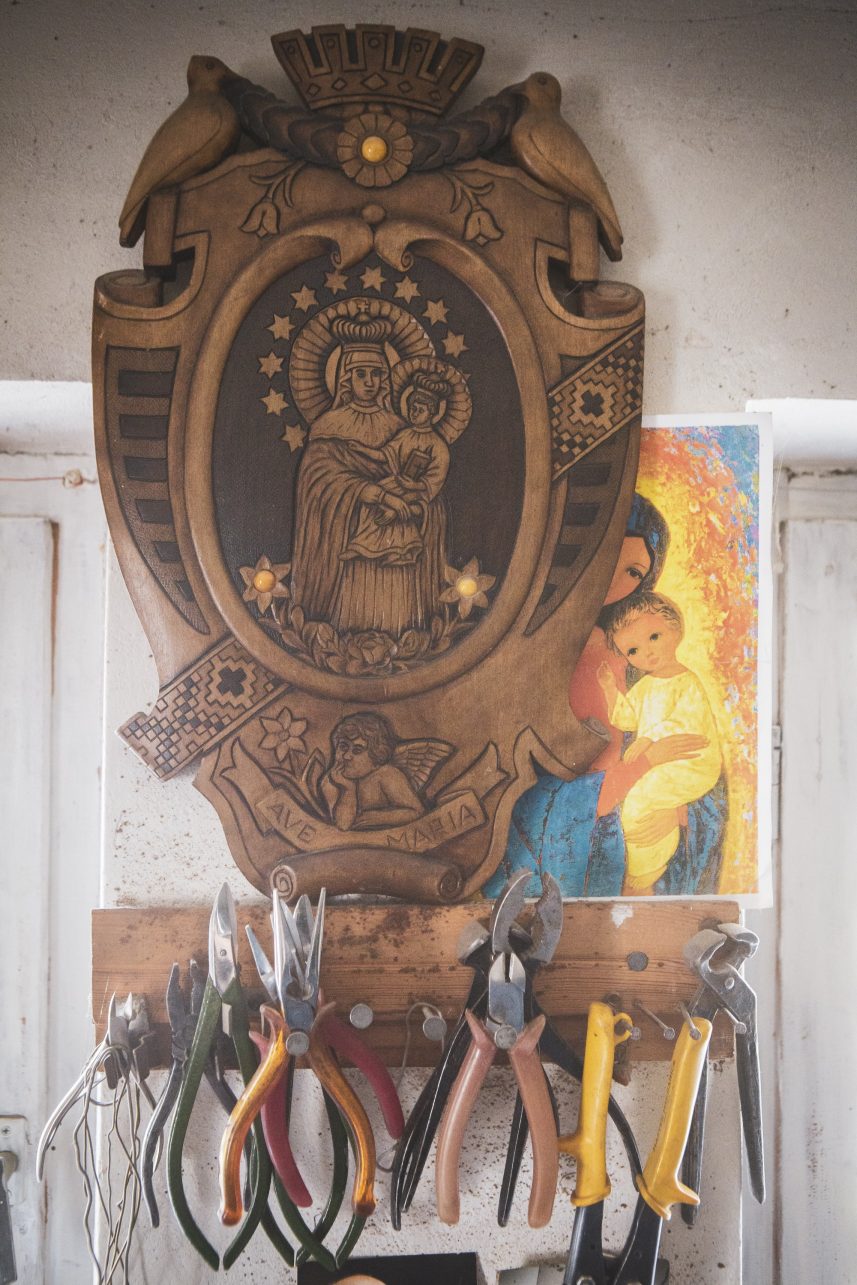
“I don’t make copies, but I work quite fast. I sit at my work desk, and it always feels like I start with a blank page. Each piece of wood is different. But as long as there is passion inside, there is energy for the little things: new discoveries and experiments,” the folk artist continues.
Adolfas says it wasn’t easy. For most of his life, he had to take on additional jobs to earn money. He devoted a lot of energy to the education of the younger generation. He spent at least a dozen years in schools and was very popular among students.
Traditions also change but remain
Now one cross-crafter makes a whole wayside shrine. He makes the pole, the little house, the statuettes, and sometimes even the tops. In the past, one craftsman was commissioned to make the wayside shrine, the figurines were carved by others, and the tips were made by the village blacksmith. It was a joint work of several authors.
We have extant examples of religious statuettes from the 18th century. The artist looks back even further. He thinks that the first traditions appeared after the Christianization of Lithuania, and we did not have pagan statues. It’s just a pity that it was customary to burn the old worn-out idols, prayer books, etc., for a long time.
Religious wood carving is not a phenomenon unique to Lithuania, but the folk artist points out that what makes us stand out is the abundance of them. Nowhere in the world will you see so much of these works. Samogitia stands out in particular; you can see a new masterpiece popping up at every turn.
This is explained by Catholicism. “It does not exist in Protestant countries. And it is quite common in Italy, Poland and here. Others may have considered it idolatry, but it is not true.”
Are Samogitian carvings different than the ones from other regions? “With the acceleration of travel and migration, distinctive features have faded, but are still noticeable. Traditions are probably more visible in textiles at the moment,” the folk artist explains the Lithuanian regional differences.
A. Teresius is quite calm about the future; he thinks there is nothing to worry about. He is especially happy with his current student Marijonas, with whom he gets along well. They often call each other in the evenings to discuss what and how they should be carving.

